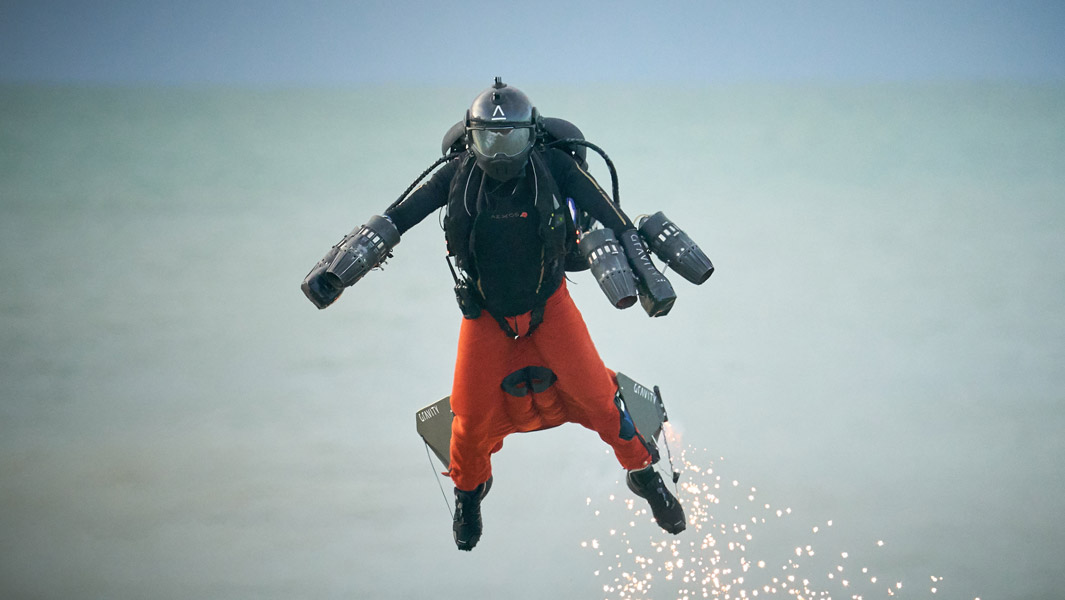Real-life Iron Man breaks speed record: 85 mph!
Great Scott!

A British Tony Stark is one step closer to the Iron Man armor, flying with its jet-engine-powered suit at an amazing 85.06 mph (136.9 km/h) over the coast of Brighton, England. Check it out in action:
The top speed broke a new world record for the fastest body-controlled jet suit according to Guinness World Records.
The suit is built and flown by inventor Richard Browning, who pulverized his previous record of 32.02 mph (51.53 km/h), which was set two years ago according to the GWR organization. Browning set the new real-life Iron Man speed limit after two attempts flying to and from a ship at the end of the famous Brighton Pier. On the first try, he broke his record with a speed of 78.5 mph (48 mph) but he wanted to see if he could go faster, so he tried a second time to get to 85 mph.
According to Browning, the experience is amazing: “"It’s pretty exhilarating, the adrenalin flows when you’re hammering along over the waves doing that [...] When you’re traveling fast over a grey ocean it’s quite difficult even for me to judge my speed. So having the pier and things like the jetski were really good."
I believe him. It must be amazing to feel that speed on your body while flying so close to the ground.

Beyond fun, military applications
Browning is the founder of Gravity Industries, which self-defines as a “human propulsion technology start-up, with the mission to re-imagine the future of manned flight.” Beyond the fun of flying, an obvious application for this technology is the military and emergency units that need to get to difficult-to-reach places fast.
The French army is already investing money in similar ideas, like the “Green Goblin” technology that could take special forces units into the air. The French military demonstrated this technology at the last Bastille Day parade.
Get instant access to breaking news, the hottest reviews, great deals and helpful tips.
The two inventions have radically different approaches. The French “Green Goblin” tech is a board on which the soldier can fly while having his or her hands free to hold a weapon and fire from the air, which seems like a huge tactical advantage over the British Iron Man suit.
Gravity Industries‘ suit needs hands to control four kerosene-powered mini-jets, which work in combination with a winged suit that provides lift and direction. This limits the freedom of the user to do other things but control the flight.
The French Green Goblin board also — which was developed over the last three years — can reach up to 500 feet and perhaps more, edging the Iron Man suit with a speed of 87 miles per hour.
The US military Iron Man
The U.S. Military is also reportedly working on an Iron Man suit codenamed TALOS. Back in 2014, President Obama announced that the U.S. indeed going in that direction. There are no demonstrations of this American suit, however. We only know the military’s initial shopping list for the project, published in this video.
Back in 2014, the Pentagon announced that "the goal is to have a contract in place by next fall and have suits ready for full field testing in about four years."
However, Talos (Tactical Assault Light Operator Suit) will not have flying capability or built-in weapons but it will focus on other things. First, ballistic and shock protection with a material that has a flexible soft surface until it gets hit, which turns it instantly to hard metal solid capable of repelling ammo. It will also be fire-resistant and store energy, as well as provide integrated communications, sensors, and a heads-up display that will give tactical battle information. Just like a videogame.
The suit will also have an optional hydraulic exoskeleton to multiply the strength and the running speed of soldiers.
As for the flying, we know that in 2016 Elon Musk visited the Pentagon to discuss his companies’ involvement in the development of a secret flying metal suit. It’s likely that all these secret and not-so-secret projects will eventually merge to create a super-soldier.
It may just be too late, though, with biped and quadruped robots quickly developing into advanced beings that could be easily weaponized.
Jesus Diaz founded the new Sploid for Gawker Media after seven years working at Gizmodo, where he helmed the lost-in-a-bar iPhone 4 story and wrote old angry man rants, among other things. He's a creative director, screenwriter, and producer at The Magic Sauce, and currently writes for Fast Company and Tom's Guide.

